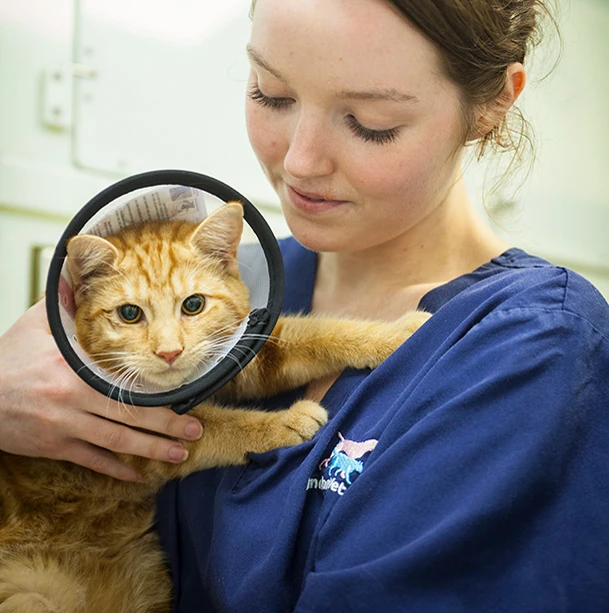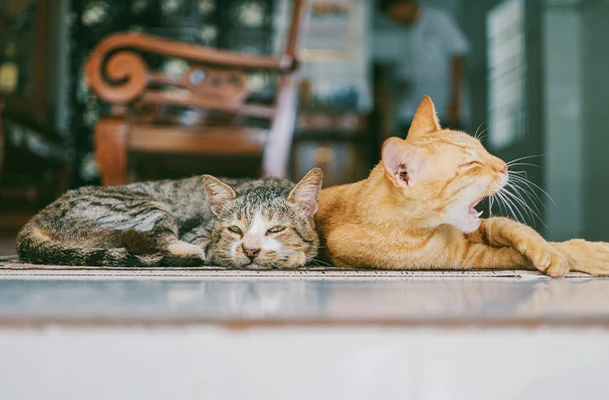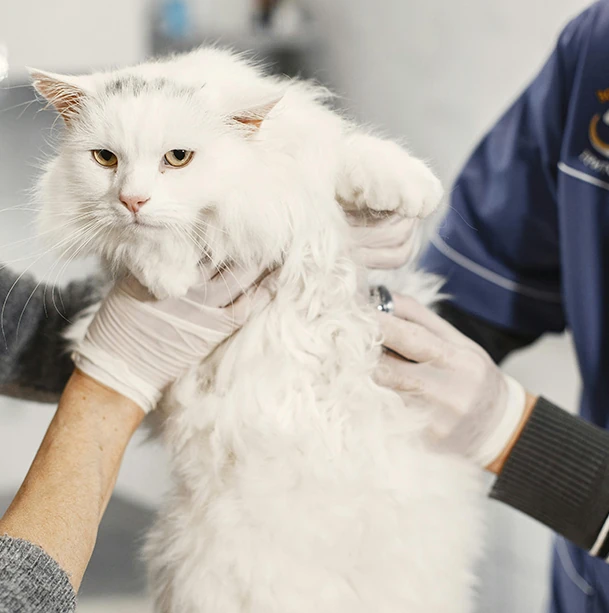Spaying queens and castrating tom cats are the most common surgical procedures we routinely undertake. There are advantages and disadvantages to both procedures.

Spaying queens and castrating tom cats are the most common surgical procedures we routinely undertake. There are advantages and disadvantages to both procedures.
‘Spaying’ is the surgical removal of the female reproductive organs. Historically, in the Anglo-Saxon world this has meant the removal of the two ovaries and the uterus – an ‘ovariohysterectomy’. When vets talk about spaying, in most circumstances we’re talking about an ‘ovariohysterectomy’.

Reasons for spaying female cats are both medical and social. Females can develop a variety of medical conditions – cancers and infections in particular – that are life threatening. Removing the source of female hormone early in life eliminates or dramatically reduces those risks. The result is that the spayed cat population (spayed early in life) lives longer than the ‘intact’ female population.
Spaying eliminates the female hormonal reproductive cycle. The spayed female does not undergo the dramatic behaviour changes of estrus – caterwauling and dragging herself around as if her rump has its own mind and mentality.

In one out of every three or four cats, spaying alters energy balance enough to lead to weight gain unless the energy level of the diet is reduced. When your cat is spayed we suggest reducing the quantity of her food anywhere from 10 to 20 per cent, or switching to a ‘neutered cat’ variety of food.
Coat length and texture are both associated with sex hormone. As a general rule, male sex hormone enhances hair growth so males are hairier than females, and the skin on their necks and forelimbs is thicker. After neutering, a female’s male hormone (She produces male hormone in her adrenal gland.) may affect her coat, which can grow thicker and more luxurious.
Over 30 years ago, French vets switched from the ‘ovariohysterectomy’, removing the ovaries and uterus, to the ‘ovariectomy’, removing just the ovaries. This is a less invasive procedure. The incision is smaller and much less tissue – only the two relatively small ovaries – is removed. By the later 1990s all continental veterinary schools had switched to the ovariectomy as their first choice neutering procedure.
British vets worried that leaving the uterus intact would lead to increased womb infections later in life but Dutch vets have shown conclusively that this is not the case. In the absence of female hormone the uterus contacts down to a thin strand. Infection is only possible if female hormone drugs (progestogens) are given to the cat and there are virtually no medical reasons for this to be done. (Cervical cancer and uterine cancer are both very rare in cats so leaving these organs intact does not increase cancer risk.)
In 2008, after discussing the European results with Professor Dick White, former head of surgery at Cambridge University’s vet school, we modified our procedures and now undertake the ovariectomy as the neutering procedure of choice. If, however, the uterus appears unhealthy, it is also removed and we perform the more extensive ovariohysterecomy.
The procedure itself is straight forward. On arrival at the clinic your dog is given a ‘pre-med’ consisting of a sedative and two forms of pain killer, one of which also has a sedative affect. During surgery a further pain killer is given. The incision is usually repaired with stitches under the skin (to reduce an interest in licking) and medical ‘superglue’ is added. A light dressing is then applied to cover the area and further reduce the risk of licking. She goes home later that day, together with non-steriod anti-inflammatory tablets or drops (pain killer) to give for several more days. Most dogs want to return to normal activity within three days but, of course, your dog should be restricted to lead exercise for a week after surgery.
We undertake the ovariectomy as the neutering procedure of choice. If, however, the uterus appears unhealthy, it is also removed and we perform the more extensive ovariohysterecomy.
The procedure itself is straight forward. On arrival at the clinic your cat is given a ‘pre-med’ consisting of a sedative and two forms of pain killer, one of which also has a sedative affect. During surgery a further pain killer is given. The incision is usually repaired with stitches under the skin and medical ‘superglue’ is added. She goes home later that day, together with non-steriod anti-inflammatory drops (pain killer) to give for several more days. Most cats want to return to normal activity within three days but, of course, outdoor cats should be kept indoors for a week after surgery.


‘Keyhole’ or ‘laparoscopic’ or ‘minimally invasive surgery’ is the normal for many human procedures (such as appendectomies or gall bladder removal). However, because cats don’t have interfering belly buttons, a feline ovariectomy can be carried out through a single small midline incision of approximately two to three centimeters. If a laparoscopic spay is preferred this is provided by Dr Elise Robertson, one of the UK’s most experienced laparoscopic surgeons.
We suggest spaying any time before the first season. This perpetuates the existing personality and is medically the best time to spay.
If you have a male cat and want him to develop secondary male features such as thicker cheek and neck skin, postponing neutering allows these physical characteristics to develop.
If you have any questions about any of these procedures please telephone the clinic and speak with one of the nurses.

Our dogs adore going to the vet so much it’s almost ridiculous, invariably starting to squeal with excitement at any sign we’re turning towards Marylebone and, on arrival, ejecting themselves from the car and dragging us through the door in their hurry to be fussed over by the lovely nurses. Bruce has been our vet since the day we brought our first puppy home in 2006. Together with the other fabulous vets, nurses, and staff at 86 York Street, they’ve seen our pets through it all, from their very first checks to the sad day when they’ve needed to be ushered kindly and gently out of pain. Over the years, they’ve removed a hiking sock from a dog’s intestines, dealt with kennel cough, clipped nails, diagnosed giardia, cured a hamster’s sniffles, sutured paws, spayed and neutered, referred to specialist vets when necessary, and helped us survive a phantom pregnancy. When one of our dogs was really ill, Helen was an absolute star, not only providing comfort and advice but moving heaven and earth to source a hard-to-get medication for her. And that’s not even mentioning the routine stuff—dispensing behavioural guidance, worming tablets, vaccines, and dietary advice, all with empathy, calm professionalism, and good humour. London Vet Clinic is one of the few true, old-fashioned, independent vet practices left in London,and we’re incredibly grateful to have our pets in their safe hands.
Jessica
My Pug Queenie has been seen by a number of the Vets at the London Vet clinic, all were brilliant, they thoroughly explained all of the procedures that my dog would be having. I’m a first-time pug owner and I have very much appreciated all their help. Queenie’s had her spay & Boas surgery here. Jo was fantastic, she did the Boas, which has been highly successful, Queenie’s been coping well with the extreme heat we have been having. Highly recommended!
Queenie
The best vet I have ever been. The staff are so nice and attentive. My dog loves going there, whichever of the doctors or the nurses are on duty the atmosphere is always so welcoming and nice. Next year will be my 10th year as a client.
Jenny P
The clinic is very caring and accommodating from the vets to the reception team. Today, they saw us on very short notice after our dog was poorly overnight. The care and attention is excellent and genuine. Thank you for taking such wonderful care of our dog.
Heather F
Absolutely amazing , I was so stressed and staff made me feel so calm and secure. Even offer cup of tea , take away of course. So professional and incredibly helpful. Wigmore (dog) feeling much better
Steve Sutton
Always a super helpful and attentive team to assist you – if you’re looking for 5* service from your vet along with top quality healthcare for your pet – look no further…
Joshua Wilkilson
Digital strategy, website development, and marketing by Living Dreams Web Development Solutions in partnership with Dr Samuela Merenda, DVM, MRCVS.